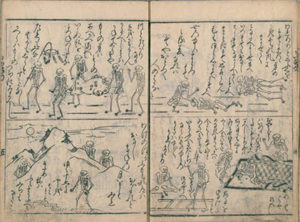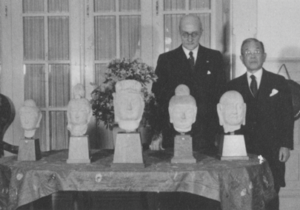Upcoming Events

Upcoming Events
New Topics, Technologies and New Times: Japan Ahead
Friday-Saturday, February 24-25
Ida & Robert Sproul Room, International House, UC Berkeley
 Academic communities play an important role in shaping international perspectives. Scholars work within broad networks, developing thoughtful insights on emerging changes long before others become aware of their implications. Students, whether within Japan and abroad, will in time become tomorrow’s leaders. How we shape their understanding of Japan establishes powerful influence on the way they will think for decades ahead.
Academic communities play an important role in shaping international perspectives. Scholars work within broad networks, developing thoughtful insights on emerging changes long before others become aware of their implications. Students, whether within Japan and abroad, will in time become tomorrow’s leaders. How we shape their understanding of Japan establishes powerful influence on the way they will think for decades ahead.
Japan’s role in the world is changing. Its long era of postwar prosperity is signaled with a rich harvest of international awards. The Nobel Prize once seemed an elusive mark of success, but by 2014, there were three Japanese-born Nobel Prize winners and in 2015, two. Japan also boasts more native-born Pritzker Prize winning architects than any other nation, in spite of its small size. But the nation’s future international influence is a larger question, its economy overtaken by China’s. Both at home and abroad, Japan faces many other unmapped challenges.
We propose to bring together scholars form Japan and the West to discuss the future of Japan in our academic communities.
Read more…
Township leaders and village chiefs in contemporary China
Tuesday, February 28 | 2:00 PM
Zhe Ren, Institute of Developing Economies, CJS Visiting Scholar
Daniel Mattingly, Stanford University
IEAS Conference Room, Suite 510, 1995 University Avenue, UC Berkeley
 The relationship between a township leader and a village chief in contemporary China is something of a political puzzle. Researchers have maintained that China’s bureaucratic system contains a very important political contracting framework. Within this framework, the career of a cadre is strongly related to the performance of a contract that may cover not only economic development but also other aspects of political and social development. Accordingly, previous research argued that political contracting was applied to leadership positions at both the town and village levels, making comparable ‘contractual’ demands on township leaders and village chiefs. Certain characteristics of the two positions, however, differ significantly in their implications for leadership performance and accountability. For instance, a cadre’s career strongly depends on his or her performances and their assessments by upper-level and high-level cadres. In contrast, one can only become a village chief through a village election. Moreover, once elected a village chief cannot be dismissed by a township government unless the village chief is convicted of a crime. Furthermore, since a village chief is an elected leader, he or she does not necessarily have a clear and strong career plan akin to that of a cadre working and seeking to rise in the bureaucratic system. For these and other reasons, it is doubtful that the conventional political contracting model can adequately explain the complex relationships that exist today between township leaders and village chiefs in China.
The relationship between a township leader and a village chief in contemporary China is something of a political puzzle. Researchers have maintained that China’s bureaucratic system contains a very important political contracting framework. Within this framework, the career of a cadre is strongly related to the performance of a contract that may cover not only economic development but also other aspects of political and social development. Accordingly, previous research argued that political contracting was applied to leadership positions at both the town and village levels, making comparable ‘contractual’ demands on township leaders and village chiefs. Certain characteristics of the two positions, however, differ significantly in their implications for leadership performance and accountability. For instance, a cadre’s career strongly depends on his or her performances and their assessments by upper-level and high-level cadres. In contrast, one can only become a village chief through a village election. Moreover, once elected a village chief cannot be dismissed by a township government unless the village chief is convicted of a crime. Furthermore, since a village chief is an elected leader, he or she does not necessarily have a clear and strong career plan akin to that of a cadre working and seeking to rise in the bureaucratic system. For these and other reasons, it is doubtful that the conventional political contracting model can adequately explain the complex relationships that exist today between township leaders and village chiefs in China.
Read more…
日本の『死の舞踏』: 『九相詩』と『一休骸骨』 Kyūsōshi and Ikkyū Gaikotsu
Friday, March 3 | 3:30 PM
Yūichirō Imanishi, National Institute of Japanese Literature
Co-sponsored by C. V. Starr East Asian Library and the National Institute of Japanese Literature
Art History Seminar Room, C. V. Starr East Asian Library, UC Berkeley
*This talk will be given in Japanese*
 ヨーロッパ中世を覆った「メメント・モリ」の思潮をもっとも雄弁に表すのは、『死の舞踏』(La Danse Macabre)という絵画で、書物としては15世紀1485年にフランスで出版された。そこには貴賤を問わずすべての人間を死へ誘う骸骨の姿が描かれている。いうまでもなく骸骨は死の象徴である。しかし、人間が死を免れないはかない存在であることは、洋の東西を問わない。日本では仏教の教えに「九相」ということが説かれていた。「九相」とは人間が死後、白骨になるまでの死体の腐敗変貌の過程の九段階のことであり、それはまさに仏教の「メメント・モリ」であった。その九相の図が描かれ、その絵に解説の漢詩と和歌を添えて『九相図』という書物が作られた。生のはかなさと生に執着することの無益を教える書物である。それは「メメント・モリ」に親しんできた西洋人、すなわち16世紀後半から17世紀はじめにかけて日本でキリスト教布教に努めた宣教師達にも注目され、布教のために出版されたイエズス会の出版物にも利用されている。『九相詩』の後、『九相詩』とはまったく別の角度から「メメント・モリ」を教える書物が出現した。『一休骸骨』である。酒を飲み踊り唄い、男女抱擁し、そして病と死、葬送、遺された者の出家・剃髪という人間の営みが、すべて骸骨の姿で示される。その絵は滑稽とユーモアにあふれているとも言えるが、その底に流れているのは、死すべきものとしての人間の究極の姿である。踊り唄う骸骨の姿は、まさに「死の舞踏」であるが、生と死を対立的に捉え生者を死へ誘うヨーロッパの骸骨とは異なり、生とは実は死にほかならないという、生死一如を表周する骸骨の姿がそこには見出される。骸骨はたんに生と対立する死の象徴なのではなく、生の究極の姿なのである。『九相詩』と『一休骸骨』の二書を取り上げて、日本中世の「メメント・モリ」について考えたい。
ヨーロッパ中世を覆った「メメント・モリ」の思潮をもっとも雄弁に表すのは、『死の舞踏』(La Danse Macabre)という絵画で、書物としては15世紀1485年にフランスで出版された。そこには貴賤を問わずすべての人間を死へ誘う骸骨の姿が描かれている。いうまでもなく骸骨は死の象徴である。しかし、人間が死を免れないはかない存在であることは、洋の東西を問わない。日本では仏教の教えに「九相」ということが説かれていた。「九相」とは人間が死後、白骨になるまでの死体の腐敗変貌の過程の九段階のことであり、それはまさに仏教の「メメント・モリ」であった。その九相の図が描かれ、その絵に解説の漢詩と和歌を添えて『九相図』という書物が作られた。生のはかなさと生に執着することの無益を教える書物である。それは「メメント・モリ」に親しんできた西洋人、すなわち16世紀後半から17世紀はじめにかけて日本でキリスト教布教に努めた宣教師達にも注目され、布教のために出版されたイエズス会の出版物にも利用されている。『九相詩』の後、『九相詩』とはまったく別の角度から「メメント・モリ」を教える書物が出現した。『一休骸骨』である。酒を飲み踊り唄い、男女抱擁し、そして病と死、葬送、遺された者の出家・剃髪という人間の営みが、すべて骸骨の姿で示される。その絵は滑稽とユーモアにあふれているとも言えるが、その底に流れているのは、死すべきものとしての人間の究極の姿である。踊り唄う骸骨の姿は、まさに「死の舞踏」であるが、生と死を対立的に捉え生者を死へ誘うヨーロッパの骸骨とは異なり、生とは実は死にほかならないという、生死一如を表周する骸骨の姿がそこには見出される。骸骨はたんに生と対立する死の象徴なのではなく、生の究極の姿なのである。『九相詩』と『一休骸骨』の二書を取り上げて、日本中世の「メメント・モリ」について考えたい。
Read more…
Courtesy Announcements
Asian Art Museum Presents New Video Art to commemorate 75th Anniversary of Japanese Incarceration during WWII
February 18-26
Asian Art Museum, San Francisco, CA
 Vintage family photos and black and white home movies crowded with joyful picnics, seaside fun, prosperous storefronts, tidy homes: the typical California dream. This dream was uprooted by the signing of Executive Order 9066 in 1942, which resulted in the incarceration of 120,000 American Japanese during WWII. From Feb. 19 – Feb. 26, 2017, the Asian Art Museum will screen When Rabbit Left the Moon, a video elegy by award-winning filmmaker Emiko Omori to commemorate the 75th anniversary of this dark chapter in American history — a chapter with lessons that continue to resonate today.
Vintage family photos and black and white home movies crowded with joyful picnics, seaside fun, prosperous storefronts, tidy homes: the typical California dream. This dream was uprooted by the signing of Executive Order 9066 in 1942, which resulted in the incarceration of 120,000 American Japanese during WWII. From Feb. 19 – Feb. 26, 2017, the Asian Art Museum will screen When Rabbit Left the Moon, a video elegy by award-winning filmmaker Emiko Omori to commemorate the 75th anniversary of this dark chapter in American history — a chapter with lessons that continue to resonate today.
Artist Emiko Omori will also appear for a dedicated panel discussion with fellow interned American Japanese on Saturday, Feb. 25 from 1-3PM at the museum. Participants include Omori’s sister Chizu Omori, psychiatrist Satsuki Ina, and artist Masako Takahashi. Moderated by Asian Art Museum deputy director for arts and programs Rob Mintz, the panel is an opportunity for participants to share thoughts on what their experiences, and the prejudices they faced, offer all Americans today.
Read more…
Yamanaka Sadajirō and Nezu Ka’ichirō’s Buddha Heads & the Modern Fragmentation and Re-presentation of Chinese Buddhist Sculpture
Thursday, February 23 | 5:00 PM
Gregory Levine UC Berkeley
Sponsored by the Asian Art and Visual Culturals Group
Doe 308a, UC Berkeley
